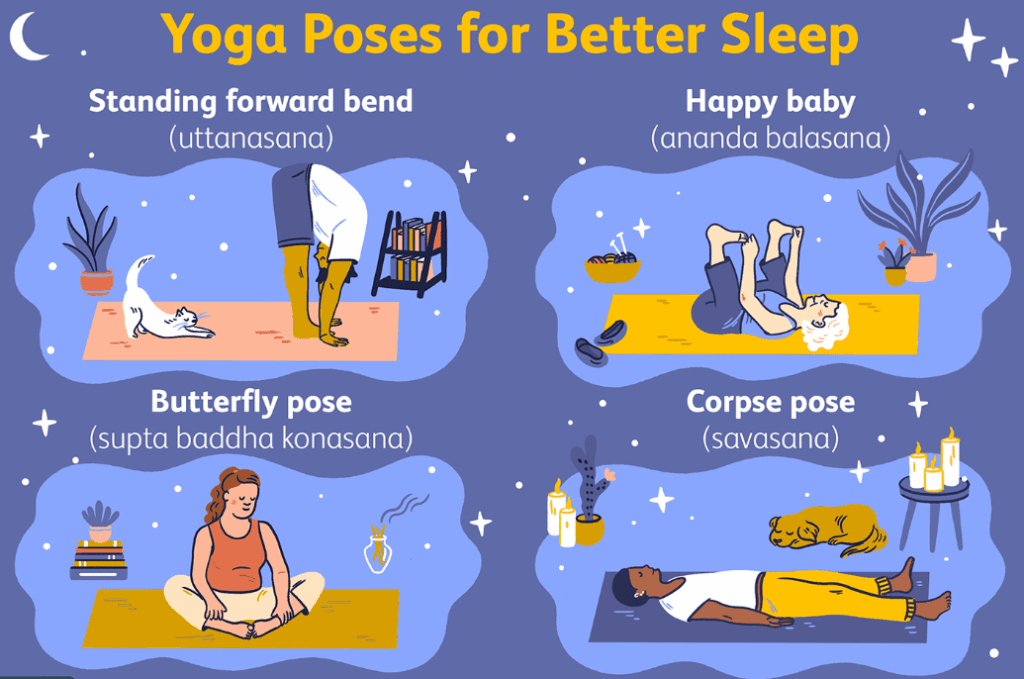You can practice restorative yoga anywhere with these four prop-free flows. Start your day with the Morning Rejuvenation sequence featuring gentle twists and modified sun salutations. Try Desk-to-Zen poses during work breaks to release tension. Wind down before bed with the Evening sequence that includes Child’s Pose and Reclined Butterfly.
When traveling, use the Travel-Friendly practice with seated twists and legs-up-the-wall. These simple flows offer profound relaxation benefits in just 10-15 minutes.
The Science Behind Prop-Free Restorative Yoga
While traditional restorative yoga often relies heavily on props like bolsters, blocks, and blankets, the body itself possesses remarkable abilities to find support and release tension naturally. Your nervous system responds to mindfulness and deep breathing techniques regardless of external tools, activating the parasympathetic response that counters stress.
Research shows that consistent restorative yoga practice lowers cortisol levels, reduces blood pressure, and improves heart rate variability. The key lies in the mind-body connection rather than equipment. When you hold gentle postures and focus on your breath, you’re creating internal conditions for relaxation and flexibility improvements.
Your body’s weight provides natural resistance and support, allowing muscles to release tension gradually through gravity alone. It proves that effective stress relief doesn’t require special props.

A 10-Minute Flow to Start Your Day
As your body emerges from sleep, it craves gentle movement to awaken muscles and stimulate circulation after hours of stillness. This quick morning yoga flow combines deep breathing with mindful stretches to energize your system naturally.
Begin in a comfortable seated position, taking five full breaths to center yourself. Shift into gentle spinal twists, followed by cat-cow poses to loosen your back. Move to tabletop position for thread-the-needle stretches to open shoulders. Stand for a modified sun salutation, focusing on body awareness rather than perfect form. Finish with standing side stretches and a forward fold to invigorate your whole system.
These morning yoga flows don’t require excessive time or props, just your breath and attention to kickstart your day.
Restorative Poses for the Workplace
The modern office environment often creates physical tension that accumulates throughout your workday. Transform your workspace into a mini relaxation sanctuary with these simple stretches you can perform right at your desk.
Start with seated shoulder rolls to release upper body tension, then try gentle neck tilts to improve mobility in your cervical spine. For lower body recovery, practice ankle circles and seated hip openers while working through emails.
When privacy allows, stand for a modified forward fold beside your chair, letting gravity help release your tight lower back. Close your sequence with a grounding breath exercise. Inhale for four counts, hold for two, exhale for six. Even three minutes of these movements can reset your nervous system and improve focus.

A Bedtime Sequence for Better Sleep
Many people struggle to disconnect from the day’s stress before sleep, yet a targeted restorative yoga sequence can considerably improve your ability to fall and stay asleep. This gentle flow practice focuses on conscious muscle release while maintaining proper alignment to signal your body it’s time to rest.
Begin in Child’s Pose, allowing your breath to deepen for two minutes. Shift to Seated Forward Fold, holding for five breaths while releasing tension in your lower back. Move to Reclined Butterfly, placing one hand on your heart and one on your belly for a brief meditation.
Finally, practice Legs-Up-the-Wall (or against your headboard) to calm your nervous system. These sequences take just 10-15 minutes but deliver profound relaxation benefits.

Travel-Friendly Restorative Practices for Stress Relief
Travel-related stress can disrupt your wellness routine, but simple restorative yoga practices offer relief wherever you find yourself. When confined to small spaces like planes, trains, or hotel rooms, focus on gentle seated twists and neck releases to alleviate tension.
Try this mini-sequence. Close your eyes and take five deep breaths. Roll your shoulders back three times, then forward. Gently tilt your ear toward each shoulder, holding for 30 seconds. Finish with seated spinal twists, placing one hand on the opposite knee and turning slowly.
Between destinations, find five minutes to lie flat with legs up against a wall. It improves circulation after long periods of sitting. Remember that consistency matters more than duration, so even brief moments of mindful movement will serve your body well.
Frequently Asked Questions
Can Restorative Yoga Help With Chronic Pain Conditions?
Yes, restorative yoga can help manage chronic pain by reducing tension, decreasing stress hormones, and promoting relaxation. You’ll find it encourages gentle movement that won’t aggravate your condition while improving body awareness.
Is Restorative Yoga Suitable During Pregnancy?
Yes, you’ll find restorative yoga especially beneficial during pregnancy. It helps relieve back pain, reduces stress, improves sleep, and creates space for connecting with your baby. Always consult your doctor first, though.
How Does Restorative Yoga Compare to Meditation for Anxiety?
Restorative yoga combines meditation’s mental focus with gentle physical postures, giving you dual anxiety relief. You’ll benefit from both mindful awareness and physical tension release, while meditation primarily calms your mind through stillness.
Can Children Practice These Restorative Flows?
Yes, children can practice these restorative flows. You’ll find they’re gentle enough for young bodies and can help kids manage stress, improve focus, and develop body awareness from an early age.
Will Restorative Yoga Interfere With My Regular Fitness Routine?
No, restorative yoga won’t interfere with your fitness routine. It actually complements it by enhancing recovery, improving flexibility, and reducing muscle tension. You’ll likely see better overall performance by incorporating both practices.





